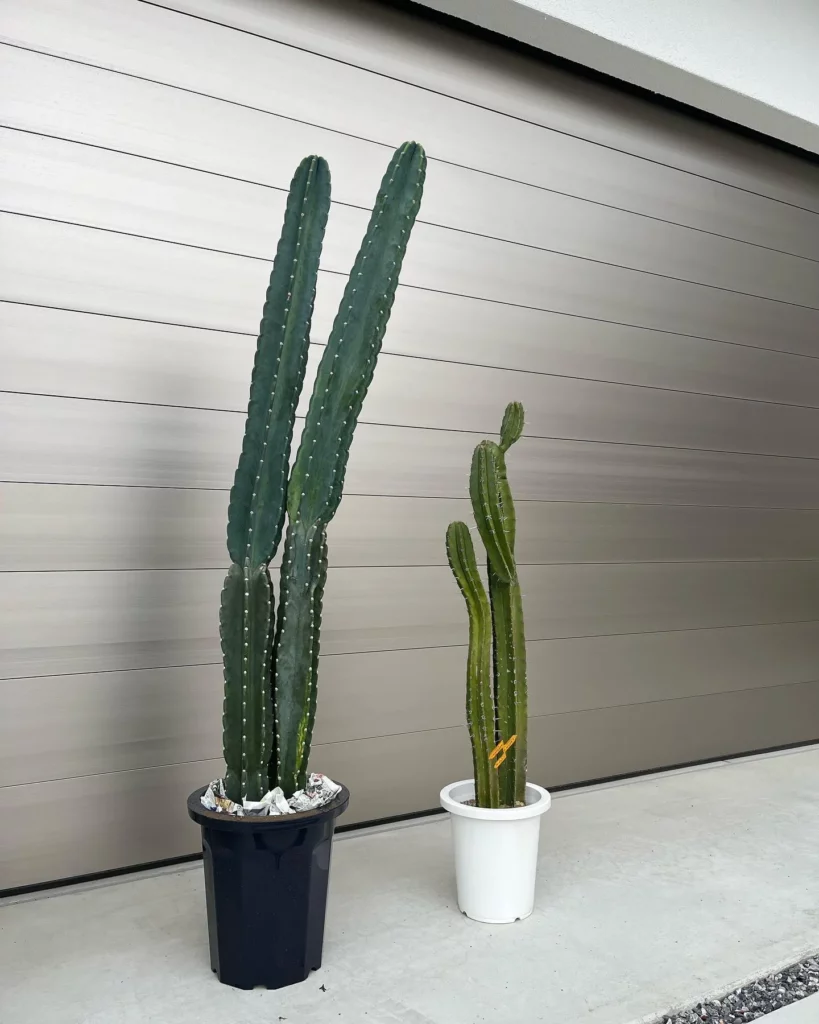The totem pole cactus, also known as Pachycereus schottii var. monstrosus, is a visually striking plant with a unique appearance. This slow-growing cactus features long, columnar stems that can reach impressive heights. Indoors, it typically grows to around 6-8 feet, while in outdoor settings, it can reach heights of up to 15 feet.
Key Takeaways:
- Choose a sunny spot for your Totem Pole Cactus, as it thrives in bright, direct light.
- Water your cactus infrequently, allowing the soil to dry out completely between waterings.
- Give your Totem Pole Cactus a boost with regular fertilization during the growing season.
- Pot your cactus in well-draining soil and repot every 2-3 years to ensure healthy growth.
- Propagation is possible through stem cuttings, but be patient as the cactus has a slow growth rate.
Appearance of Totem Pole Cactus
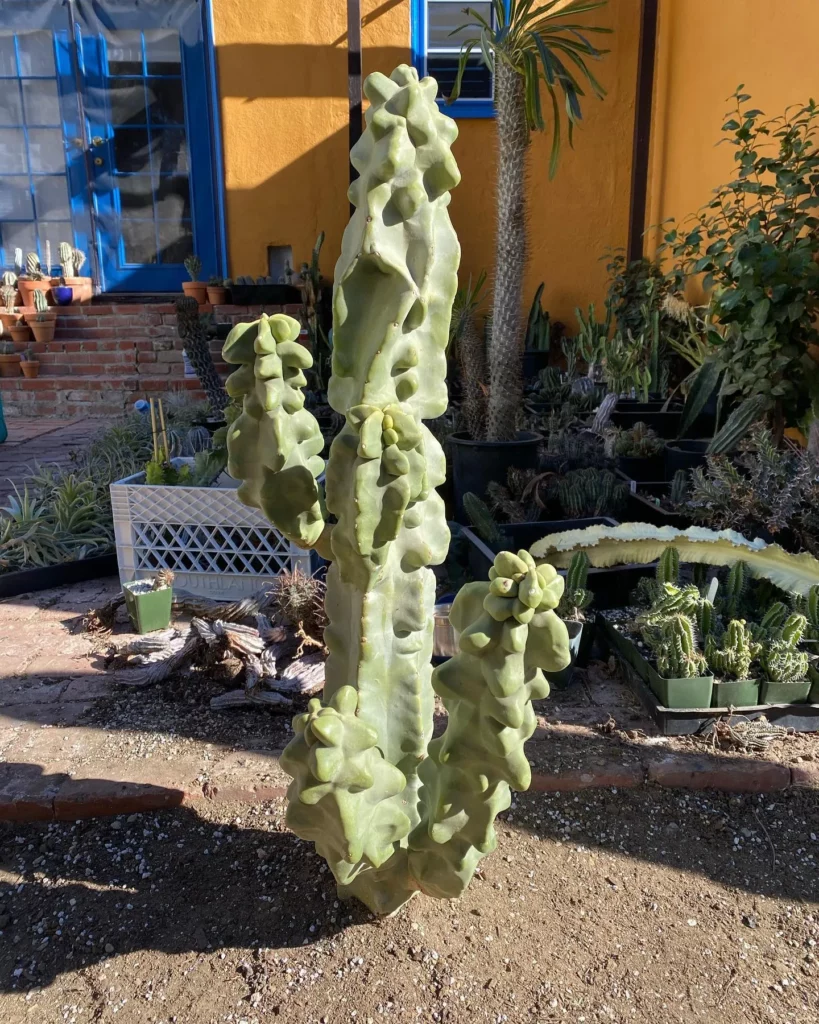
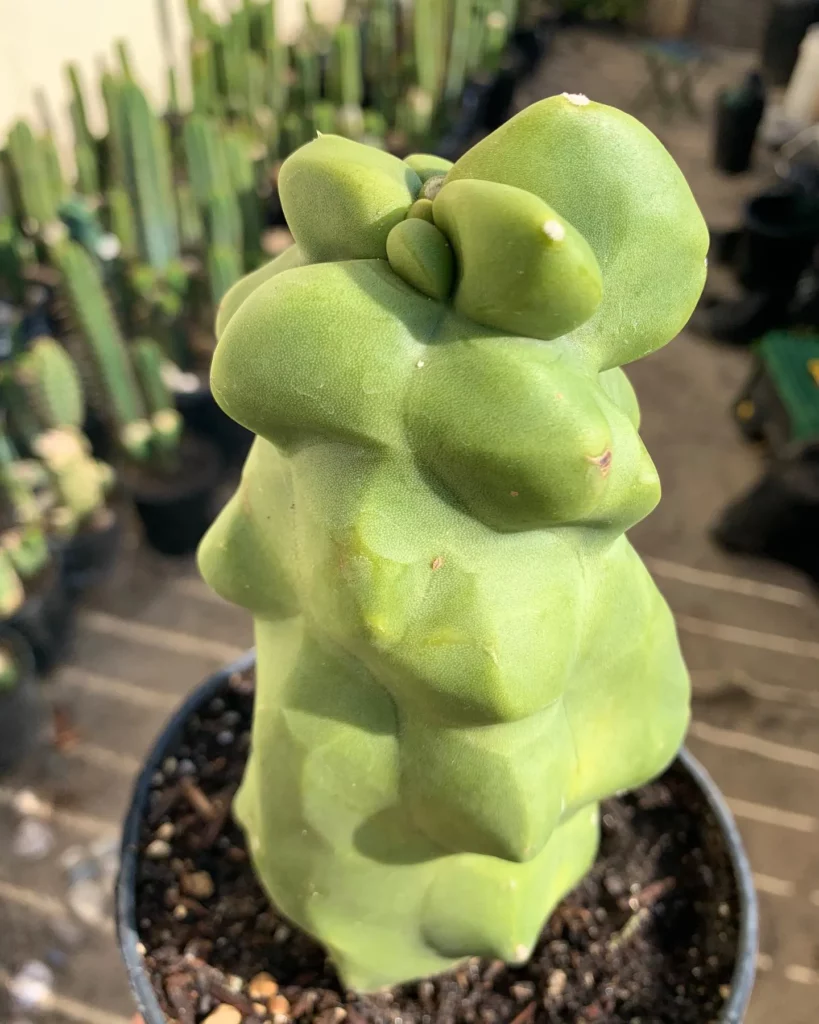
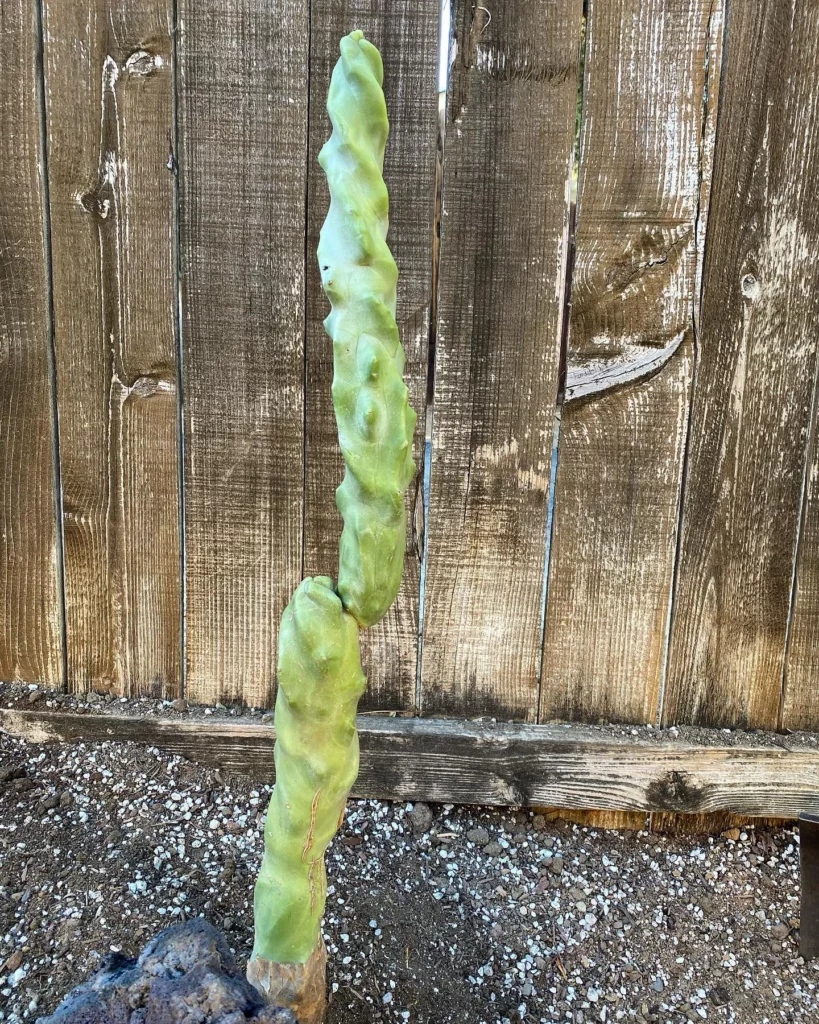
The skin of the totem pole cactus is smooth and green, adorned with small bumps or areoles that resemble carved faces. Unlike many other cacti, the totem pole cactus does not have visible spines, making it a safer option for households with children or pets.
In addition to its distinctive shape, the totem pole cactus produces beautiful light pink blooms in the spring. While the cactus itself is a sight to behold, these delicate flowers add an extra touch of beauty to its overall appearance.
Growth and Development
- Totem pole cacti have a slow growth rate and can take many years to reach their maximum height.
- In their natural environment, they can grow up to 15 feet tall and wide.
- Indoors, they usually reach heights of 6-8 feet.
- Over time, the cactus develops multiple upright arms, and fallen stems can root along their sides.
Overall, the totem pole cactus is a visually captivating plant that can serve as a stunning centerpiece in any indoor or outdoor space. Its tall, columnar stems and unique, bumpy skin make it a true conversation piece, while its low-maintenance nature adds to its appeal as a decorative plant.
Light Requirements for Totem Pole Cactus

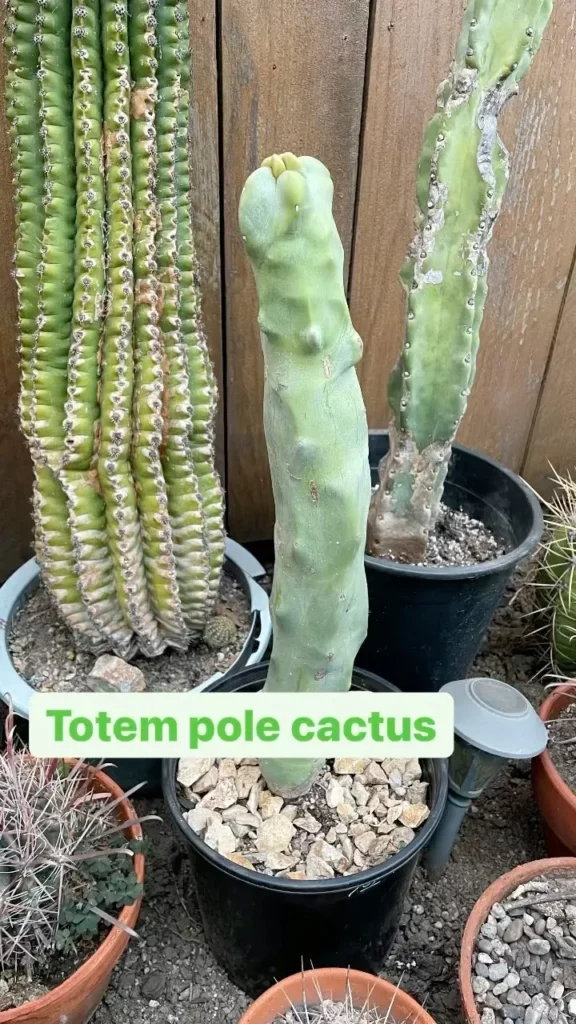

The totem pole cactus, being a desert plant, thrives in bright, direct sunlight. It requires several hours of sunlight every day to maintain its health and vibrant appearance. So, when selecting a spot for your totem pole cactus, choose a location that receives ample sunlight. Ideally, place it in front of west- or south-facing windows to provide the cactus with the necessary light it needs to thrive.
Here are the key light requirements for totem pole cactus:
- Plenty of bright, direct sunlight
- Several hours of sunlight each day
- Ideal locations are in front of west- or south-facing windows
Watering Totem Pole Cactus


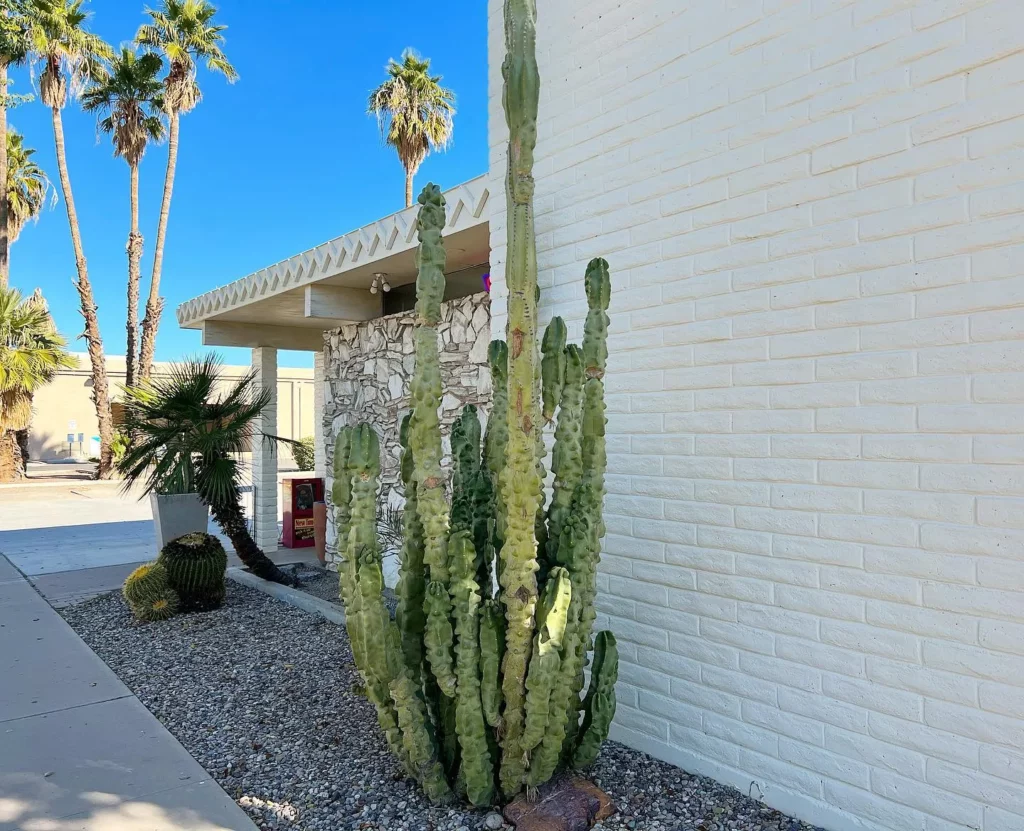
Proper watering is crucial for the health and survival of the totem pole cactus. As a drought-tolerant plant, it has adapted to thrive in arid conditions and needs infrequent watering to prevent root rot. Here are some important guidelines to follow when watering your totem pole cactus:
1. Allow the soil to dry out completely:
Before watering the cactus, make sure the soil is completely dry. Stick your finger about an inch into the soil to check for moisture. If it feels dry, it’s time to water. Overwatering can lead to root rot, so it’s better to underwater than overwater these cacti.
2. Water deeply but infrequently:
When it’s time to water, give your totem pole cactus a thorough soaking. Water until it drains out of the bottom of the pot. This ensures that the water reaches the roots and flushes out any accumulated salts. However, avoid frequent watering as the cactus prefers a dry environment.
3. Adjust watering frequency based on the season:
The watering needs of the totem pole cactus can vary depending on the season. During the summer when the cactus is actively growing, you may need to water it once every 1-2 weeks. In the winter, when growth slows down, watering once a month is usually sufficient.
Fertilizing Totem Pole Cactus
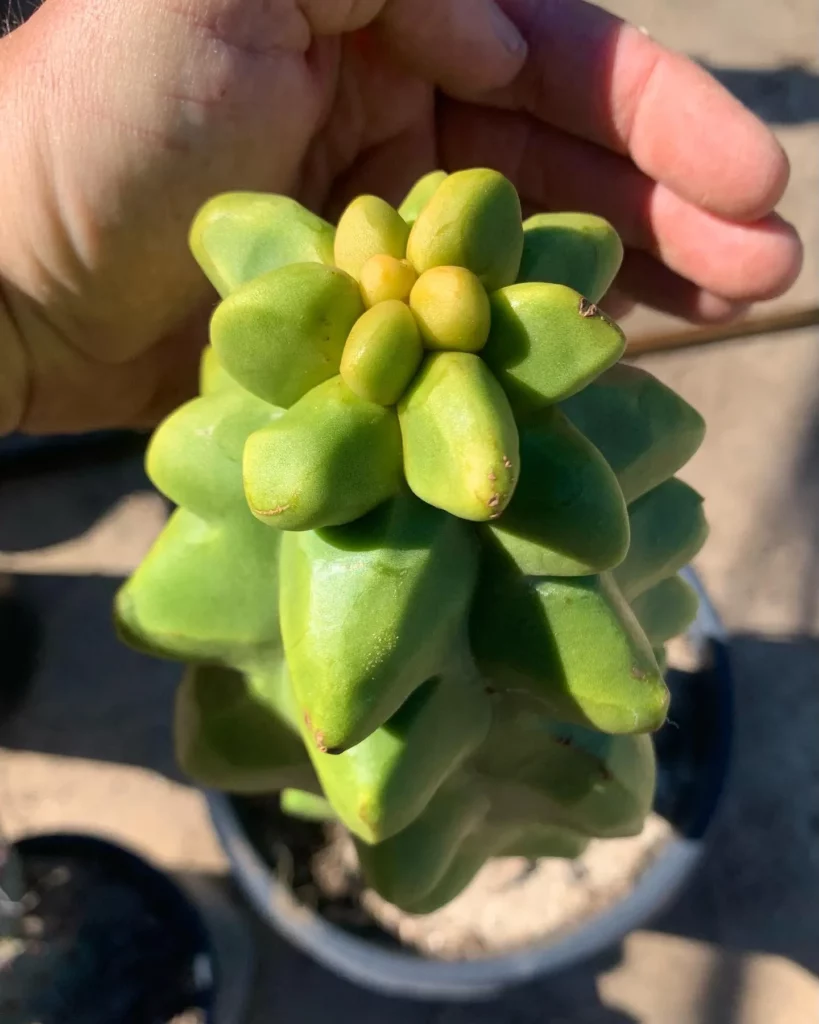
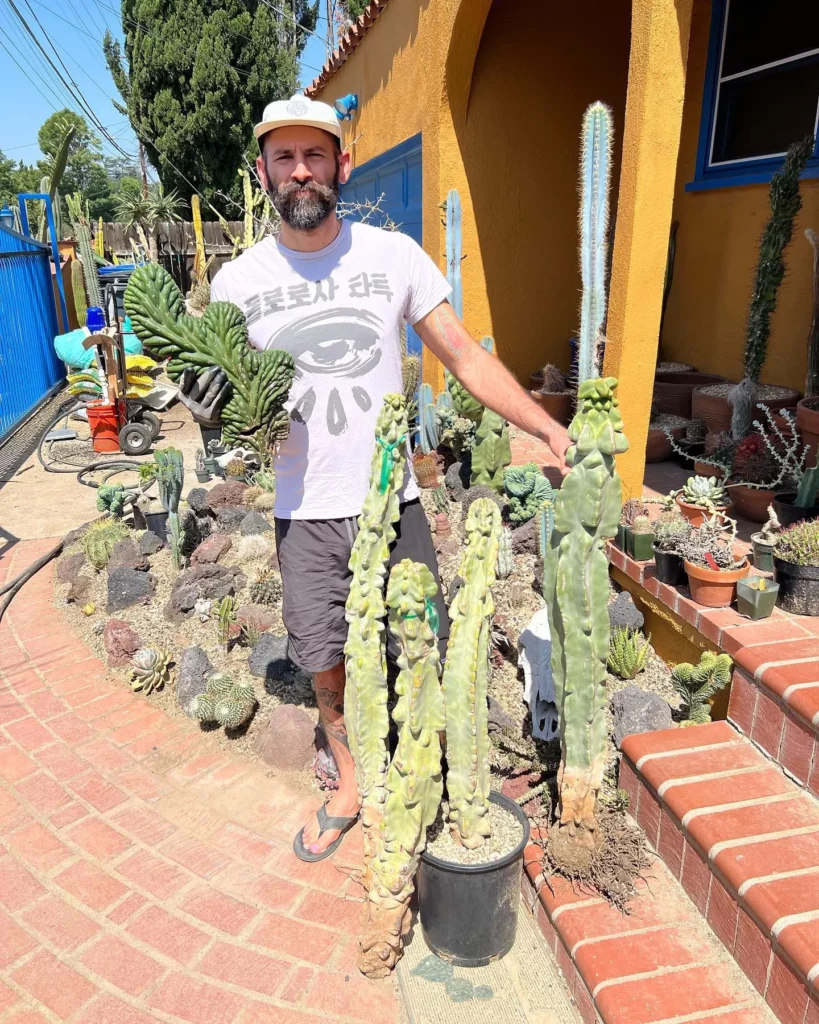
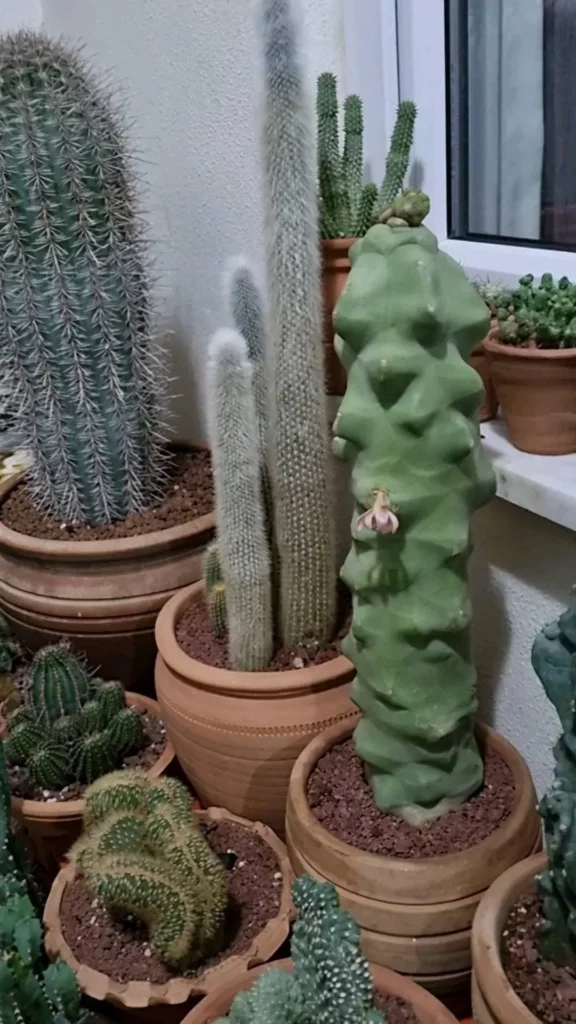
Fertilizing the totem pole cactus is an important aspect of its care to ensure healthy growth and vibrant appearance. While these cacti are not heavy feeders, they can benefit from regular fertilization during the active growing season. Applying a cactus fertilizer once a month in the spring and summer will provide the necessary nutrients for optimal growth.
When selecting a fertilizer for your totem pole cactus, choose one specifically formulated for cacti and succulents. These fertilizers are designed to provide the right balance of nutrients without causing over-fertilization. Follow the manufacturer’s instructions for application rates and dilution ratios.
How to Fertilize
To fertilize your totem pole cactus, dilute the cactus fertilizer with water according to the package instructions. Apply the diluted fertilizer to the soil around the base of the cactus, taking care not to get any on the stems or skin. Water the cactus lightly after fertilizing to ensure the nutrients reach the roots.
During the winter months, when the totem pole cactus is in a period of dormancy, it is best to refrain from fertilizing. The cactus requires less nutrients during this time and over-fertilization can cause harm. Resume fertilizing in the spring when the cactus begins its active growth phase.
Fertilizing your totem pole cactus regularly will help promote healthy growth and ensure it remains a stunning addition to your plant collection or landscape. Remember to always follow the instructions provided with the fertilizer and adjust the frequency and amount based on the specific needs of your cactus.
Potting Totem Pole Cactus
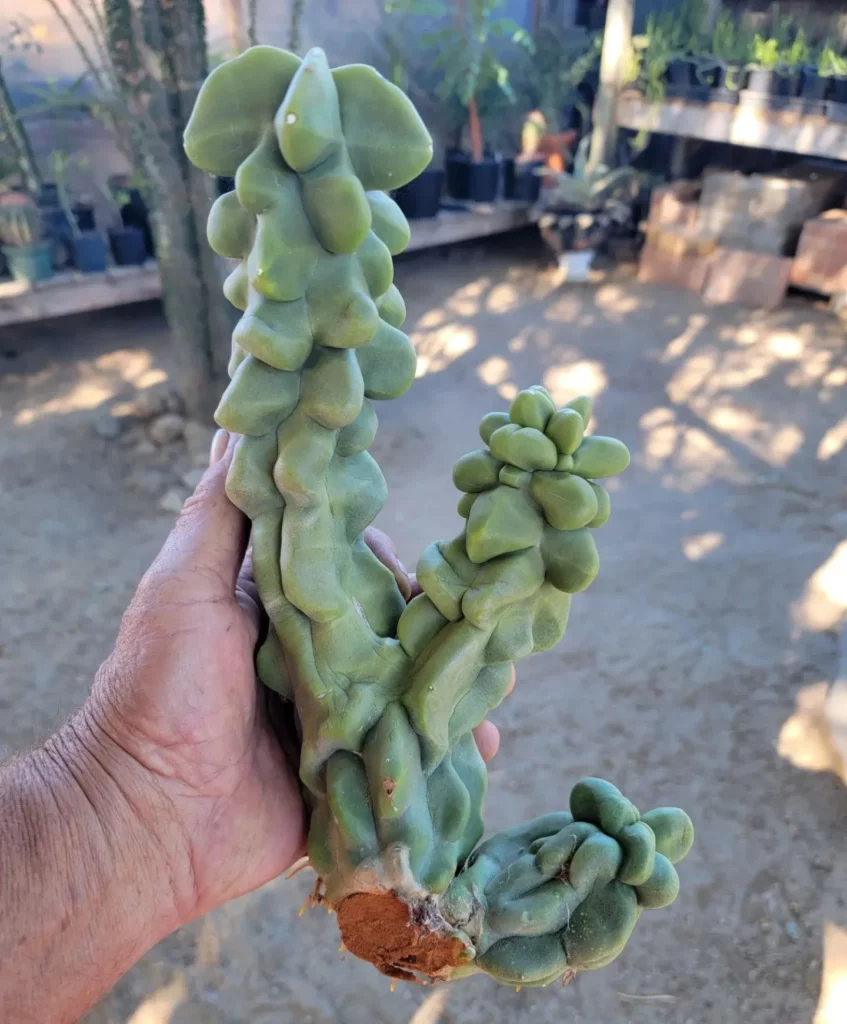

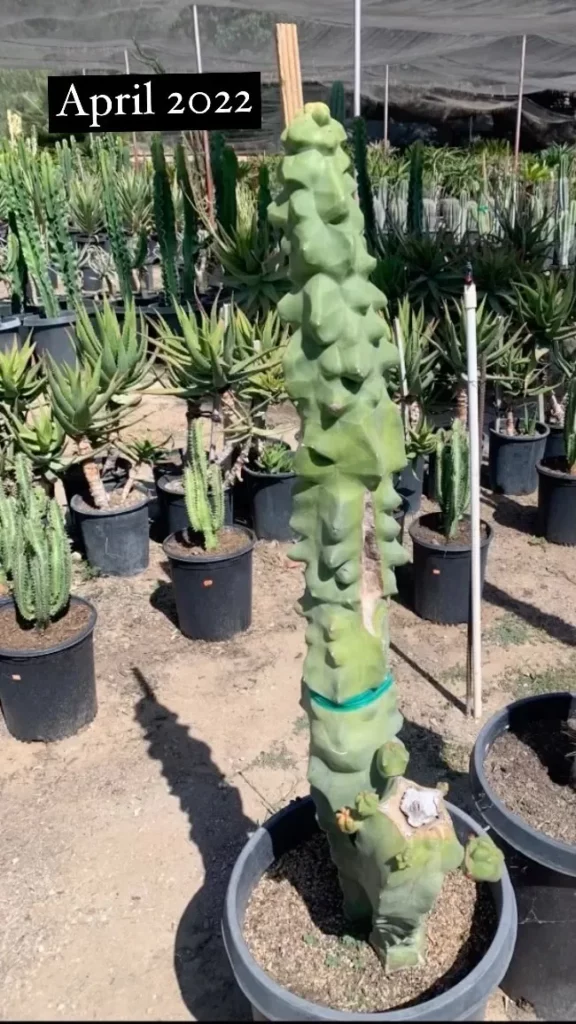
When it comes to potting your totem pole cactus, it is important to choose the right soil and container. These cacti thrive in well-draining soil, such as cactus or succulent soil. If you want to create your own mixture, you can combine equal parts indoor potting soil, sand, and perlite to ensure proper drainage.
When selecting a pot, choose one that is slightly larger than the current container. This will allow room for the cactus to grow without being too crowded. Make sure the pot has drainage holes at the bottom to prevent waterlogged soil.
Here are some steps to follow when potting your totem pole cactus:
- Prepare the potting soil mixture or select a well-draining cactus or succulent soil.
- Gently remove the cactus from its current container, taking care not to damage the roots.
- Place a layer of the potting soil mixture at the bottom of the new pot.
- Position the cactus in the center of the pot and fill in the remaining space with the potting soil, gently pressing it down around the roots.
- Water the newly potted cactus lightly to settle the soil, being careful not to overwater.
Propagation of Totem Pole Cactus
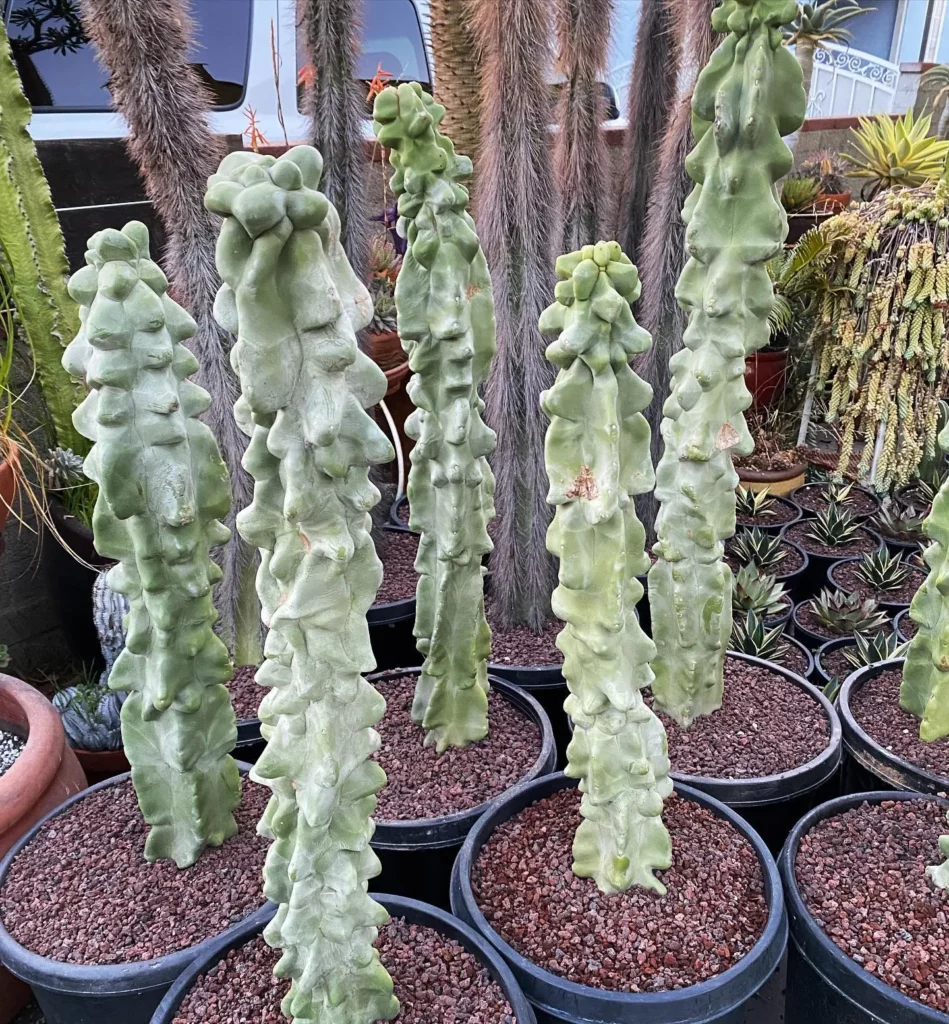
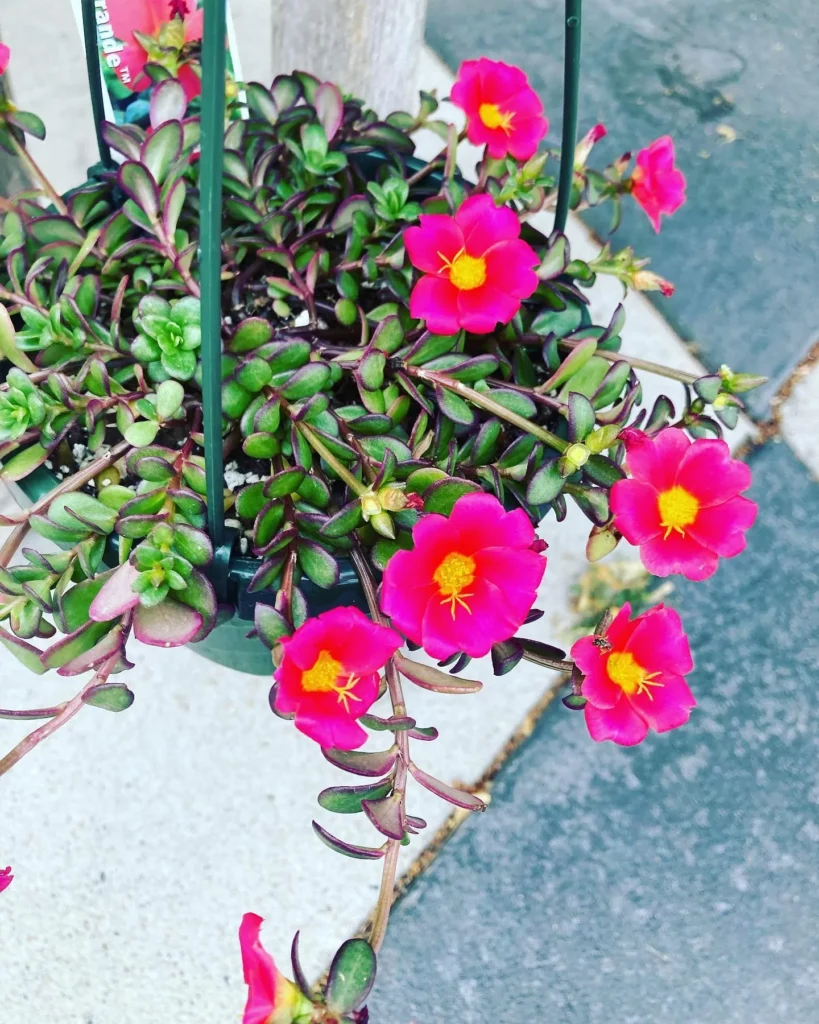
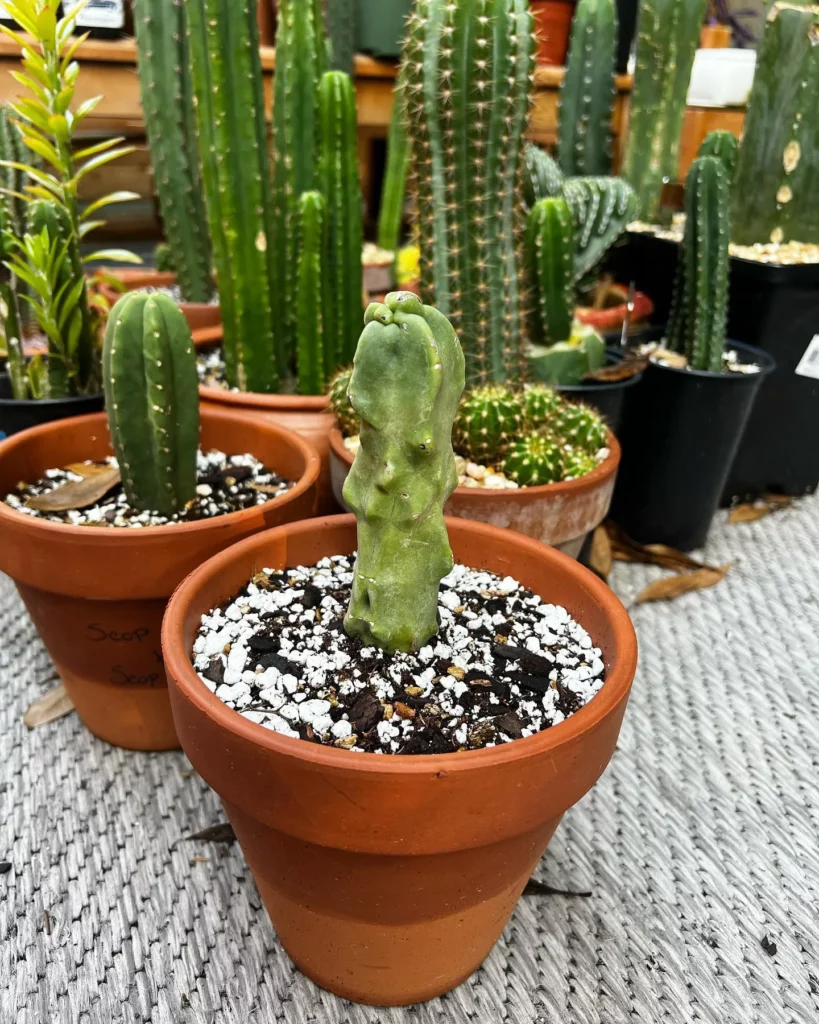
One of the fascinating aspects of totem pole cactus care is its ability to be propagated through stem cuttings. This means that you can easily create new plants from existing ones, expanding your collection or sharing them with fellow cactus enthusiasts.
Here’s a step-by-step guide to propagating your totem pole cactus:
Gather Materials:
- Sharp, clean gardening shears or a knife
- Small pots or containers with drainage holes
- Cactus or succulent potting mix
- Sand or perlite (optional) for improved drainage
- Rooting hormone powder (optional)
Take Stem Cuttings:
- Select a healthy stem of the totem pole cactus that has at least one areole. Areoles are small raised bumps on the cactus’s skin, from which spines or new growth emerge.
- Using your shears or knife, make a clean cut just above and below an areole. Aim for a cutting that is about 6 to 8 inches long.
- Allow the cut ends of the stem to dry and callus for at least 24 hours. This helps to prevent rotting and promotes the development of roots.
Plant the Cuttings:
- Fill your pots or containers with a well-draining soil mix, such as cactus or succulent potting mix. You can improve drainage by adding sand or perlite to the mix.
- If desired, dip the cut end of the stem in rooting hormone powder to promote root growth.
- Make a small hole in the soil and gently insert the cut end of the stem into the hole, ensuring that it is stable and upright.
- Lightly tamp down the soil around the stem to secure it in place.
Growth and Development of Totem Pole Cactus
The totem pole cactus has a slow growth rate, but with patience and proper care, it can reach impressive heights both indoors and outdoors. In its natural habitat, this cactus can grow up to 15 feet tall and wide, creating a striking presence in the landscape. When grown indoors, it typically reaches heights of 6-8 feet, making it a perfect choice for those who want a tall and unique houseplant.
As the totem pole cactus matures, it develops multiple upright arms, adding to its distinctive appearance. Over time, fallen stems have the ability to root along their sides, leading to the growth of new plants. This natural propagation process allows the cactus to expand and create a stunning cluster. It’s truly fascinating to witness the growth and development of this unique cactus as it takes shape and becomes a focal point in your space.
Nurturing Growth: Tips for Optimal Development
- Provide ample sunlight: The totem pole cactus thrives in bright, direct light. Place it in front of west- or south-facing windows where it can receive several hours of sunshine each day.
- Use well-draining soil: Opt for a cactus or succulent soil mix that allows water to flow through easily. This ensures that the roots don’t sit in excess moisture, reducing the risk of root rot.
- Avoid overwatering: Totem pole cacti are drought-tolerant and only require infrequent watering. Allow the soil to dry out completely between waterings to prevent overwatering and promote healthy growth.
- Fertilize sparingly: While not heavy feeders, totem pole cacti can benefit from regular fertilization during the active growing season. Apply a cactus fertilizer once a month in the spring and summer to provide essential nutrients.
Pests of Totem Pole Cactus
When caring for your Totem Pole Cactus, it’s important to be aware of the potential pests that can impact its health. Here are some common pests that may affect your cactus:
- Mealybugs: These small, cotton-like insects can gather on the stems and in the crevices of the Totem Pole Cactus. They feed on sap and can cause damage to the plant if left untreated.
- Scale: Scale insects are small, immobile pests that attach themselves to the cactus and feed on plant juices. They often appear as small bumps on the stems of the cactus.
- Aphids: Aphids are tiny, soft-bodied insects that feed on the sap of the Totem Pole Cactus. They can multiply quickly and cause damage to the plant if not controlled.
Preventing Root Rot
While pests can be a nuisance for your Totem Pole Cactus, another threat to its health is root rot. This condition occurs when the cactus’s roots are exposed to excessive moisture, leading to root decay. To prevent root rot:
- Ensure that your cactus is potted in well-draining soil.
- Water your cactus sparingly and allow the soil to dry out completely between waterings.
- Avoid overwatering, as this can lead to the development of root rot.
- Make sure to empty any excess water from the saucer or pot tray to prevent water from sitting around the roots.
Diseases of Totem Pole Cactus
The totem pole cactus is generally a hardy plant, but there are a few diseases that can affect its health and appearance. The most common disease concern for this cactus is root rot, which occurs when the roots are exposed to excessive moisture for prolonged periods. To prevent root rot, it is essential to allow the soil to dry out completely between waterings and ensure that the potting mix is well-draining.
Signs of root rot include a mushy, brown discoloration of the stems. If you notice these symptoms, it is crucial to take immediate action to save your plant. Remove the affected parts of the cactus with a clean, sterile knife, making sure to remove any rotten or mushy tissue. Allow the remaining healthy portion of the cactus to callus for a few days before replanting it in fresh, well-draining soil.
Another disease that can affect the totem pole cactus is soft rot, which is caused by bacteria and fungi. Soft rot typically occurs when the cactus is exposed to overly wet conditions or when there is poor air circulation around the plant. Signs of soft rot include a slimy, foul-smelling appearance of the affected areas. To prevent soft rot, make sure to provide adequate air circulation around the cactus and avoid overwatering.
Preventing Diseases in Totem Pole Cactus
- Use a well-draining soil mix to prevent waterlogged conditions and root rot.
- Avoid overwatering the cactus and allow the soil to dry out between waterings.
- Provide good air circulation around the plant to prevent the development of soft rot.
- Inspect the cactus regularly for any signs of disease, such as discoloration or rotting.
- If disease is detected, take immediate action to remove the affected areas and prevent further spread.
Conclusion
After exploring the various aspects of totem pole cactus care, it’s clear that this unique plant is a great addition to any plant enthusiast’s collection. Whether grown indoors or outdoors, the totem pole cactus offers a stunning focal point with its tall, columnar stems and interesting carved face-like patterns.
To ensure the health and vitality of your totem pole cactus, it’s crucial to provide it with the right conditions. This includes placing it in a sunny location with several hours of direct light each day, using well-draining soil to prevent root rot, and watering it infrequently to mimic its natural drought-tolerant habitat.
Regular fertilization during the active growing season and consistent monitoring for pests and diseases are also essential for maintaining the beauty of your totem pole cactus. By following these care guidelines, you can enjoy the striking presence and low-maintenance nature of this fascinating cactus for years to come.
FAQ
How tall can a totem pole cactus grow?
Totem pole cacti can reach heights of 6-8 feet indoors and up to 15 feet outdoors.
Does the totem pole cactus have spines?
No, the totem pole cactus does not have visible spines.
How often should I water my totem pole cactus?
Totem pole cacti should be watered infrequently, allowing the soil to completely dry out between waterings. In the summer, watering once every 1-2 weeks is usually sufficient, while in the winter, watering once a month is enough.
How much sunlight does a totem pole cactus need?
Totem pole cacti require several hours of bright, direct light every day. Placing them in front of west- or south-facing windows is ideal.
How often should I fertilize my totem pole cactus?
Applying a cactus fertilizer once a month in the spring and summer is recommended.
What kind of soil should I use for my totem pole cactus?
Totem pole cacti should be planted in a well-draining soil mix, such as cactus or succulent soil. A sandy, well-draining mixture can also be created by combining equal parts indoor potting soil, sand, and perlite.
How do I propagate a totem pole cactus?
Totem pole cacti can be propagated using stem cuttings. Cuttings should be taken from healthy stems with at least one areole, allowed to callus for 24 hours, and then planted in a pot with cactus soil.
How long does it take for a totem pole cactus to reach its maximum height?
Totem pole cacti have a slow growth rate and can take many years to reach their maximum height. In their natural environment, they can grow up to 15 feet tall and wide.
What pests are totem pole cacti susceptible to?
Totem pole cacti are susceptible to pests such as mealybugs, scale, and aphids.
What diseases can affect a totem pole cactus?
The main disease concern for totem pole cacti is root rot, which can be caused by overwatering and poorly draining soil.

